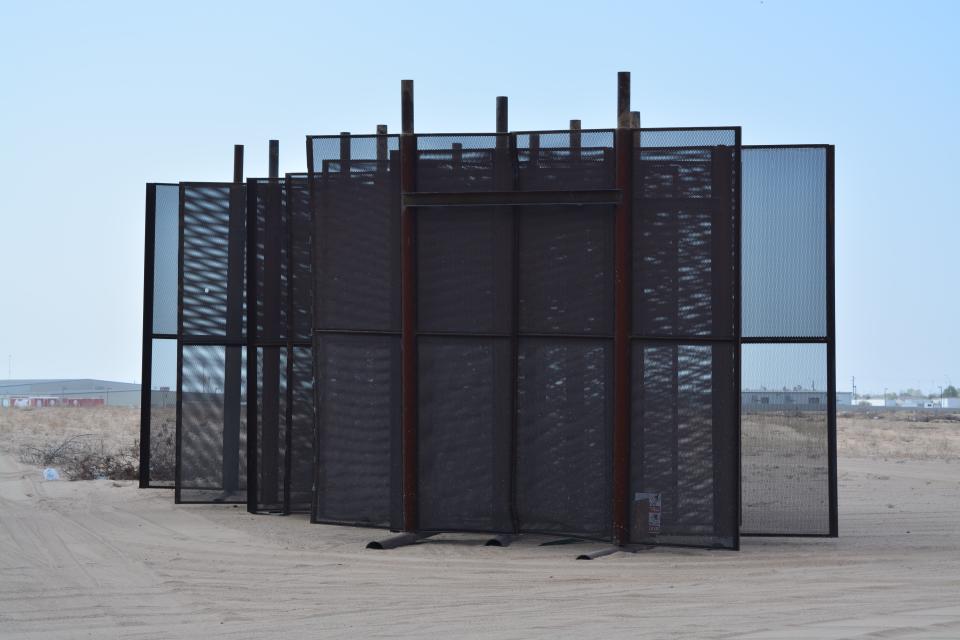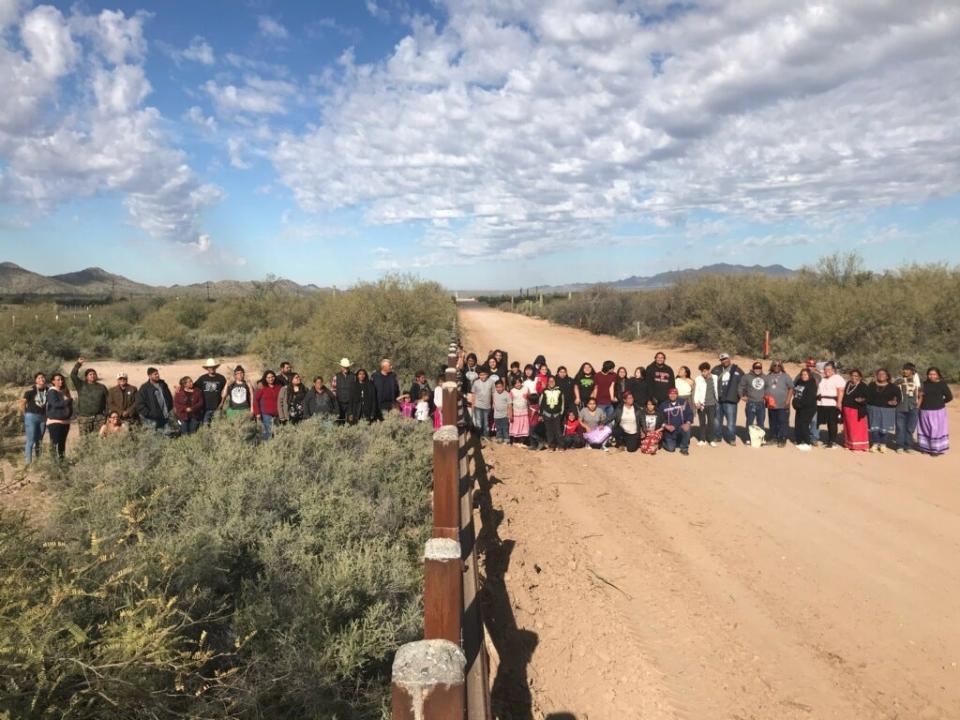Death, debt, and degradation: Trump’s border wall after four years

In the border town of San Luis, Arizona, down a county road, through a bone-dry field, a plaque with the presidential seal beams in the September sun. Donald Trump visited this stretch of border wall in June to commemorate 200 miles of new construction. He signed the wall nearby.
Outside of the pandemic response and inaction on climate change, the Trump administration has had the biggest impact on immigration, with the wall its most potent symbol.
The president’s enthusiasms for it are undiminished. At October rallies in Wisconsin and Florida, Mr Trump claimed it’s “almost built” (it isn’t) and, as ever, “Mexico is paying for it” (they aren’t).
Four years in, the wall’s promised influence, slowing immigration and drug smuggling, is disputed at best. What the wall has done, according to scholars and activists, is help kill hundreds of people, ravage the environment, bend legal norms, and drive a steel wedge into cultural ties that transcend borderlines.

The president once promised a wall spanning the entire border, but according to US Customs and Border Protection (CBP), as of mid-October, the administration built 371 miles of border barriers, including upgrading older barriers and building 16 miles of new primary walls where none stood before.

It has identified roughly $15 billion to spend on the project, projected to be the most expensive wall ever built. What that has bought America remains contested.
“It’s critical to enhancing our overall operational capacity to know who and what is coming across our borders to do us harm,” said Mark Morgan, CBP Acting Commissioner, at a 14 October speech. “When I hear that walls are ineffective, it’s just not true,” he added.
Announcing his candidacy, Mr Trump said immigrants and drugs traveling across the Southwest border needed to “stop fast,” but that hasn’t exactly happened, according to Border Patrol statistics. Rather, a shift has occurred.
“For about the first year following Trump's inauguration, we saw massively decreased flows, and we call that a ‘Trump effect,’ where potential migrants were waiting to see if the administration would immediately construct a wall across the entire border,” said Jessica Bolter, a policy analyst at the non-partisan Migration Policy Institute.
Apprehensions at the Southwest border fell by more than 100,000 people between fall 2016 and 2017.
When the total wall never materialized, immigration, especially from Central American families, shot back up over the next two years, with 977,509 total apprehensions by fall 2019.
This created a political and humanitarian crisis. The Trump campaign instituted sweeping changes including drastically slashing asylum numbers, “zero tolerance” family separation, mass detention of children, expanding the use of privately run detention facilities, and forcing migrants to remain in Mexico as they waited for asylum. All this, plus a pandemic, changed the pool of immigrants back towards Mexican men looking for work, as it had been in previous decades.
The wall also helped cause the longest US government shutdown in history between December 2018 and January 2019, with Congress ultimately denying the president most of the billions he sought for construction. Instead, that February, the president declared a national emergency and diverted billions in Pentagon funds to stop what Mr Trump called the “invasion of people” at the border, a move now being challenged in the Supreme Court.
“It’s hard to tell what exactly comes from the wall, and what comes from the many other restrictive measures the Trump administration has implemented at the border,” Ms Bolter says.
And any analysis of the wall is now swamped by coronavirus. In March, the administration effectively locked down the border.
What can be attributed more directly to the wall is death.
“The most devastating effect will undoubtedly be the increasing of migrant deaths as they get pushed further and further into dangerous deserts and isolated mountain areas,” says Chris Zepeda-Millán, a University of California, Los Angeles professor who co-authored Walls, Cages, and Family Separation: Race and Immigration Policy in the Trump Era. “That’s literally our stated policy.”
In 1994, the Clinton administration Border Patrol introduced the “prevention through deterrence," which tightened security at common border crossings like Tijuana and El Paso to push migrants into the backcountry and ideally put them in “mortal danger.”
During the first three years of the Trump administration, an average of about 460 migrants died crossing the border, according to Mr Zepeda-Millán, roughly 100 more than the yearly average the previous two decades, and also likely a massive undercount.
Harshness, towards the earth and the people who live on it, is the wall’s defining feature.
In 2017, NPR reported the Department of Homeland Security, which oversees CBP, suspended environmental regulations like the National Environmental Policy Act, Clean Water Act, and Endangered Species Act to expedite construction. Groups like the Tohono O’odham Nation and Center for Biological Diversity have sued the administration and supported lawsuits arguing the wall will massively disrupt the fragile border ecosystem, and many are concerned walls along the Rio Grande will exacerbate flooding.
The same all-or-nothing approach has been used with private landowners, who own much of the acreage along the border. The Trump administration has launched more than 100 lawsuits, many during the pandemic, to seize these parcels.
These significant consequences are in service of a policy that most Americans haven’t wanted the last four years. While there used to be something of a bipartisan consensus around building the wall, once Mr Trump adopted it as an idea, surveys have consistently shown that the majority of Americans don’t support it.
Neither do some Trump officials themselves. President Trump’s former chief of staff, John Kelly, once told lawmakers the president was not “fully informed” about the practical impact of a wall and persuaded him it wasn’t necessary.
But doing something broadly popular or thoughtfully implemented was never entirely the point. The wall was always meant to be a symbol and a political tool.
“All walls are used to create a physical and mental divide between the people outside of them and the people behind them,” Prof. Zepeda-Millán says. “Here in the US, due to the president's rhetoric and the US’s long history of demonizing Latinos and Mexicans in particular, the wall has become an extremely racialized symbol of who belongs and who doesn't.”
Mr Trump’s advisors reportedly introduced the idea of a wall in 2014 because they knew it would fire up his base, and it was a simple way to get the president to remember to mention immigration on the campaign trail. The president, a natural showman, read the room, and has said he likes using the wall as an applause line when people get bored at his rallies.
Matt Mackowiak, a conservative political consultant based between Washington, DC, and Texas, says the wall resonated with Republicans out of a mix of fear and frustration.
“For a lot of people it comes out of fear, and the biggest reason they care about it is they’ve heard a lot of cheap talk from Republicans about border security over the years, and it rarely amounts to very much,” he says, “but Trump made a commitment, and he’s followed through with it.”
According to UC Berkeley geographer Michael Dear, a “third nation” of roughly 10 million people live in communities spanning the line, and this president’s wall gambit, along the US’s broader approach to border security, has radically altered what used to be a much freer exchange of people, culture, and commerce across the border.
“What you’re seeing is a severe disruption to a centuries-old connection,” he says. “The border is a connector, not a seperator, for the people that live in the communities down there.”
For certain native tribes, nations millenia before the US or Mexico ever existed, the wall has been especially devastating. Their families and lands stretch across both sides of what’s now the line, and their identity and spirituality is inextricably linked to the land and ecosystem being cleaved.

For example, wall construction in Organ Pipe Cactus National Monument in Arizona, allegedly done without proper tribal consultation, has threatened A’al Vappia, also known as Quitobaquito Springs, which is sacred to the Hia-Ced O'odham tribe. It has also meant destroying Saguaro cacti, Ha;can in the O’odham language, which the O’odham regard as ancestors watching over them. Construction has also involved blowing up grave sites.
“It does feel like rape,” says Lourdes Pereira, a student activist at Arizona State University and member of the Hia-Ced O’odam. “They’re just raping the land, and being destructive, and desecrating sacred sites.”
But no amount of hardware on the border will ever stop people from coming, according to Ms. Bolter, the policy analyst.
“There’s never going to be a point of militarization that the US can get the border to that would completely stop all these flows,” she says. “The environmental and security push factors that are driving people to leave, as well as economic push factors, especially during and in the wake of the pandemic—there’s always going to be reasons to migrate.”
People head north to America for myriad reasons totally unrelated to the border line itself: regional economic imbalances; the destabilizing effects of NAFTA; the lingering security consequences of US-backed coups and guerillas; America’s role in exporting gangs like MS-13 to Central America; and, course, climate change, for which the US is disproportionately responsible. The wall, for all its symbolic heft, will not fundamentally change what drives immigration; it will only channel the end-results.
Joe Biden has vowed to halt wall construction and pursue comprehensive immigration reform if elected, but that has eluded modern presidents since 1986. Walls are long, but history is longer.
Read more
Supreme Court to hear Trump appeal of ruling over border wall funding
US officials clash with peaceful indigenous protestors on sacred land


